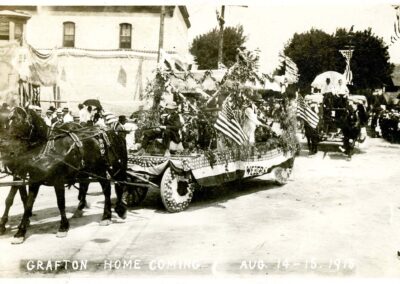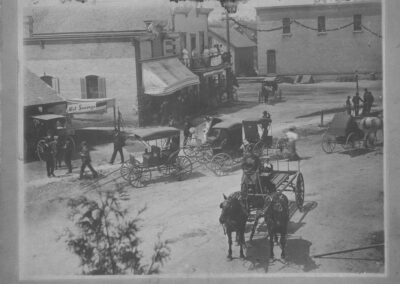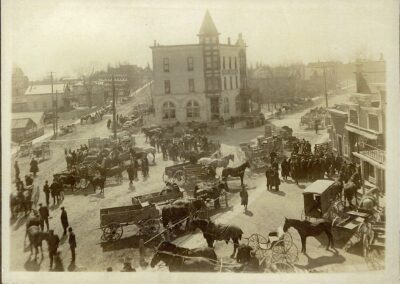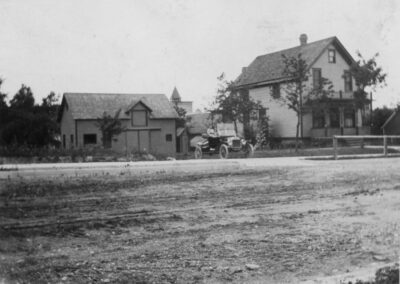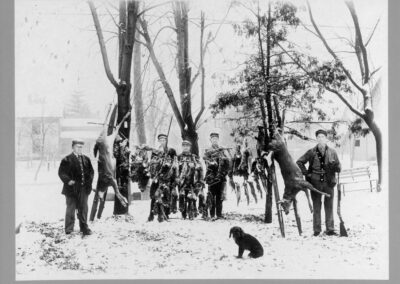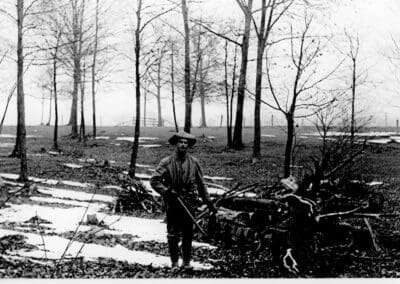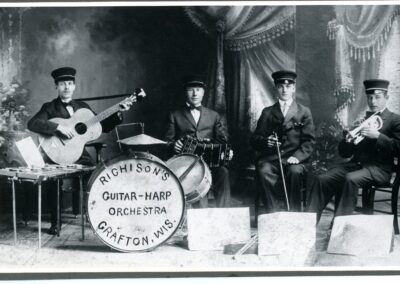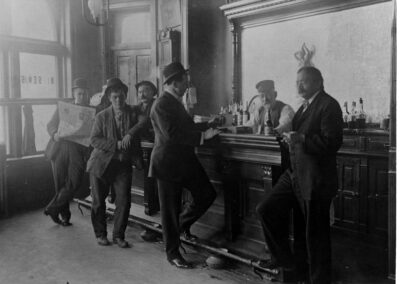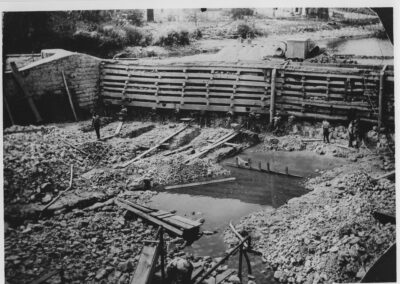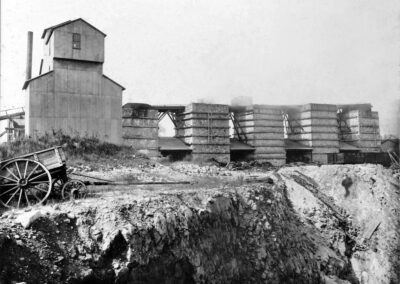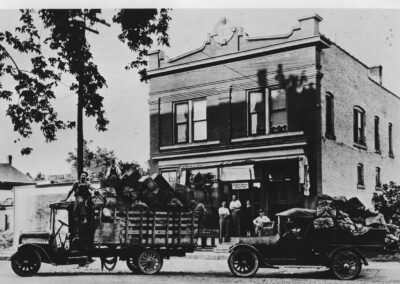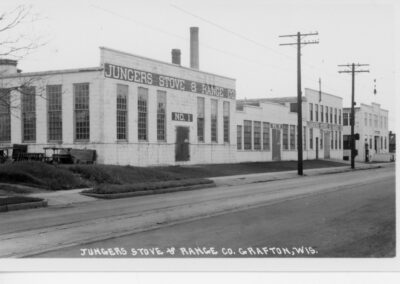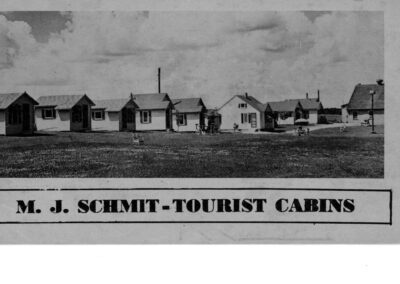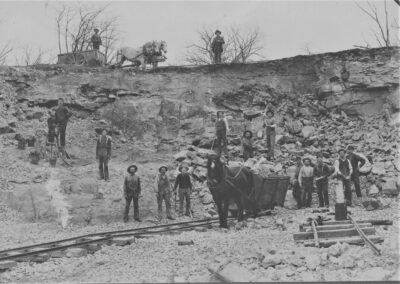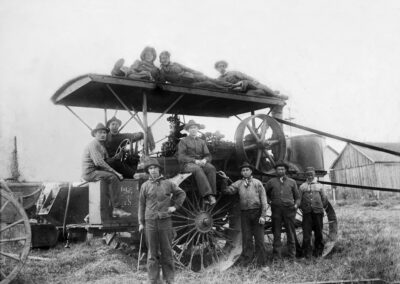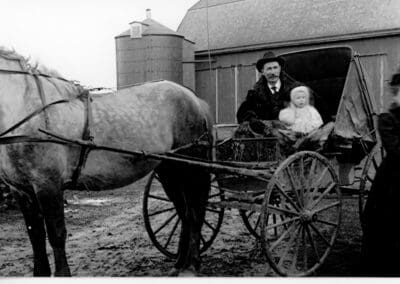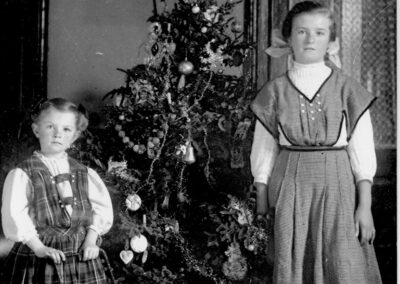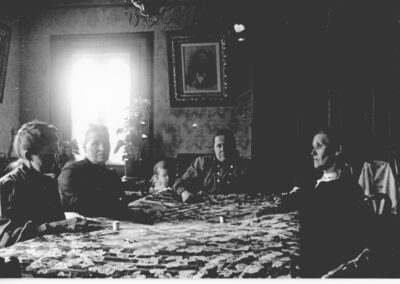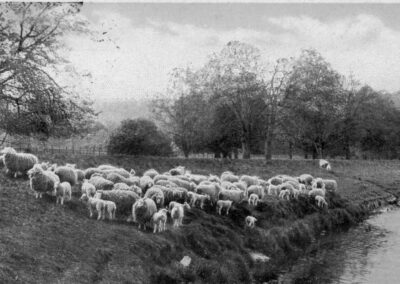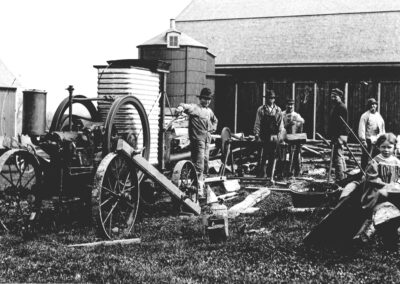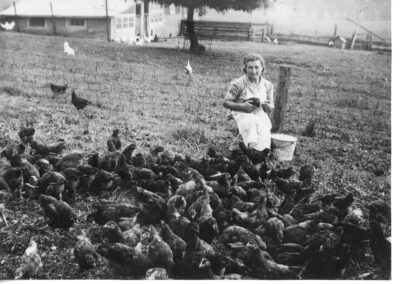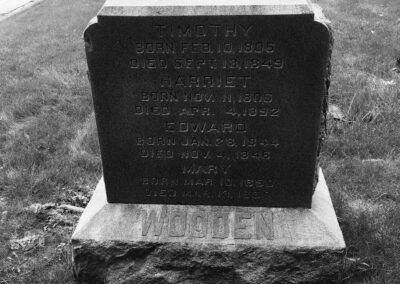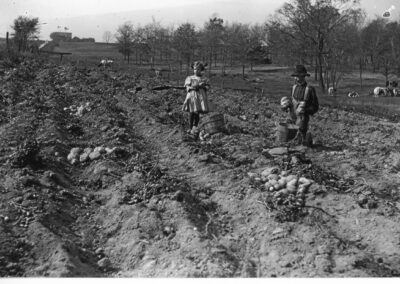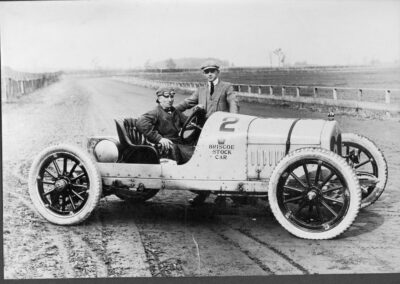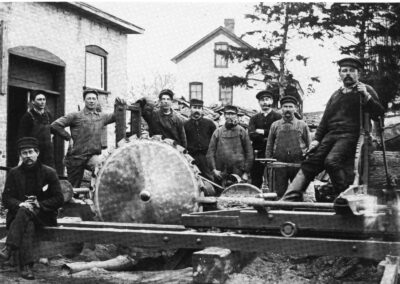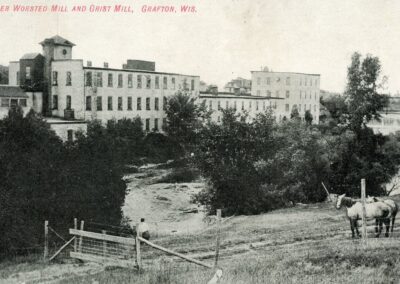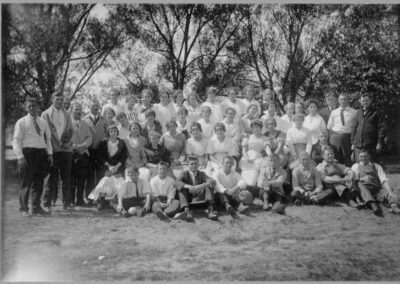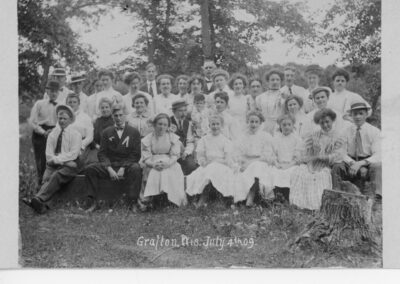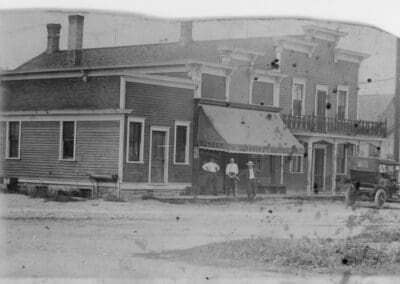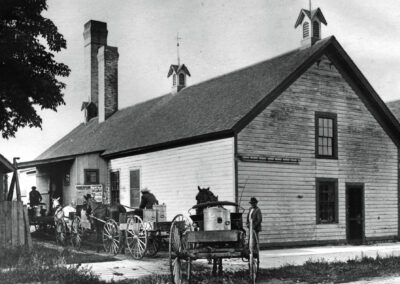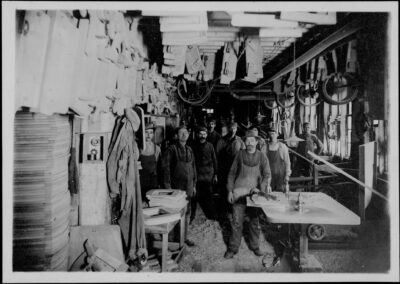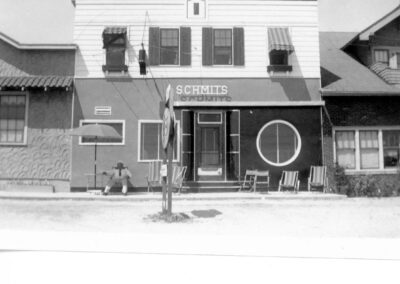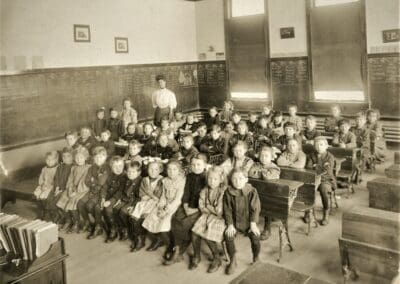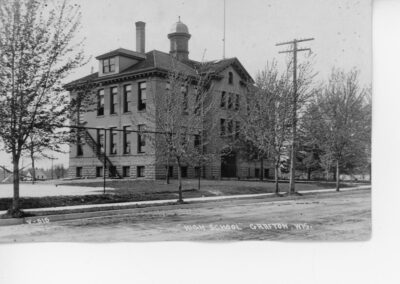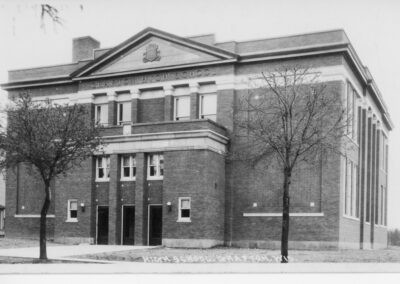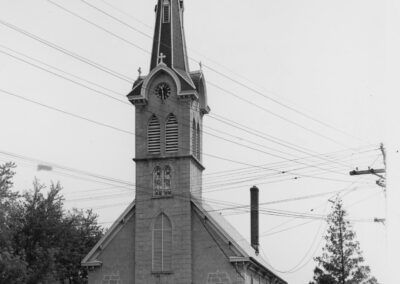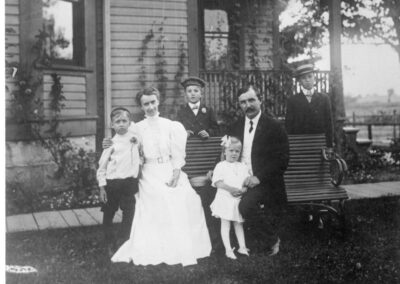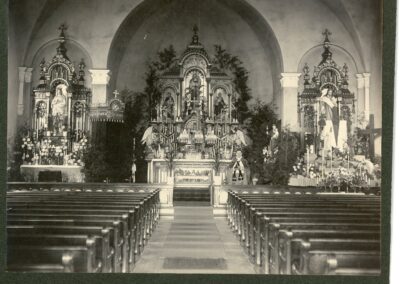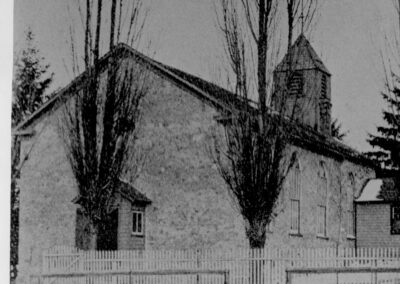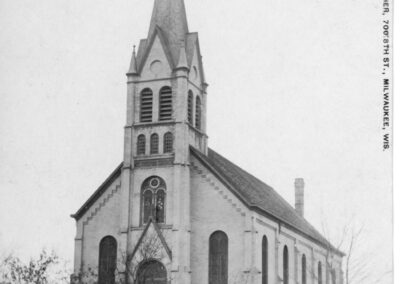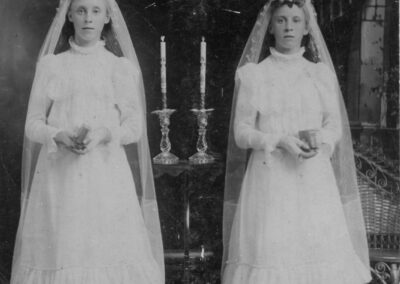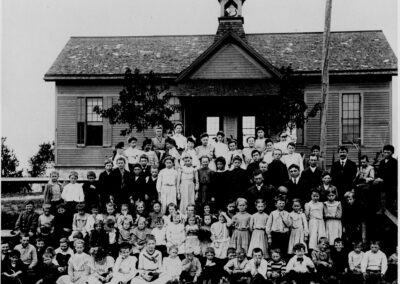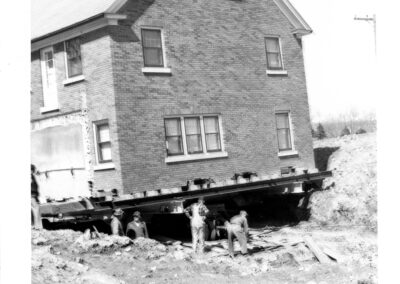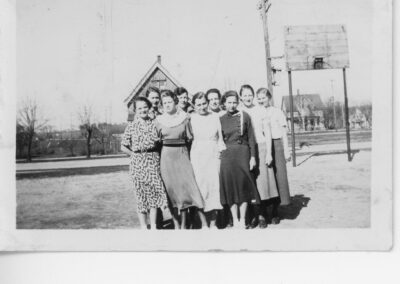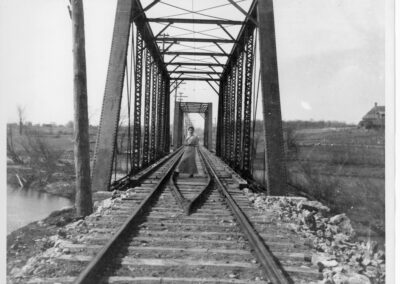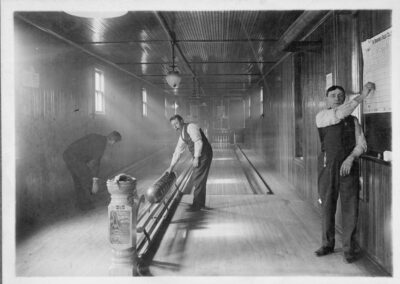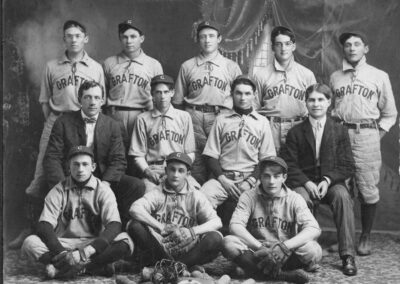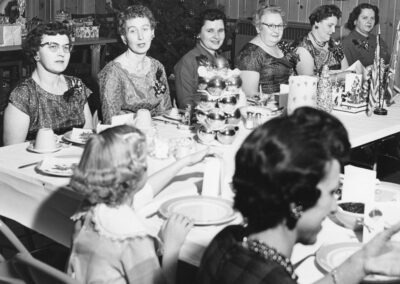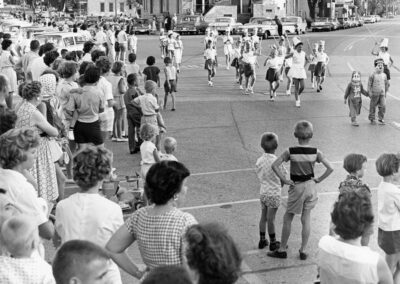Grafton Fire Department Tournament
The first Grafton Fireman’s Picnic and Tournament was held in 1899. As the village grew, so did the fire department. In 1899 a hook-and-ladder wagon and team of horses were purchased for $4. (Courtesy of the Grafton Fire Department.)
Manchester, Wisconsin
This postcard shows one of the early names of Grafton. In 1840, Jacob Eichler named the area Hamburg. In 1846, Benjamin Moore changed the name to Grafton, and in 1857 the name was changed to Manchester. In 1862, it was changed back to Grafton. (Courtesy of Nic Schanen.)
Grafton Square
People begin to gather in Grafton’s square in this scene from the early 1900’s. The view is looking north on Wisconsin Avenue. The photograph was probably taken from the Hotel Grafton. (Courtesy of the Ozaukee County Historical Society.)
Market Day
Grafton’s square was busy on this 1906 market day. Market day was the first Monday of the month and everything from pigs to shoes was sold, mostly by barter. Market day ended when people began to object to having live animals brought into the downtown area. (Courtesy of the Grafton Historical Society.)
Veterinarian Home
This scene shows the home of Grafton veterinarian Dr, Joseph Oberst, at 1327 13th Avenue. Dr. Oberst was born in Belgium, Wisconsin and moved to Grafton in 1902 where he began his practice. The house is still standing today. (Courtesy of Leone Buchholz.)
St. Paul Church Choir
These 10 men enjoying outdoor choral practice are part of the St. Paul Lutheran Male Choir. Conductor Mercken Slager is at far right. This scene was capture in 1910. (Courtesy of St. Paul Lutheran Church.)
The Hunt, 1918
These hunters proudly pose after a successful hunt. They would board the interurban with their guns and dogs, and it would take them to where they wanted to hunt and then bring them back again with their game. Pictured here from left to right are Carlie Melcars, ?Hackbardt, Charlie Rilling, Jim Wegner and Gust Wegner. (Courtesy of Nola Wegner.)
Skunk Trapper
A type of hunting in early Grafton was hunting to clear skunks from farmers’ lands. Shown here is Fred Prowatzke, a skunk trapper, with his catch. Early entrepreneurs would use skunk oil to produce a chest ointment that was thought to be good for whooping cough or croup. (Courtesy of Arnold Kaul Sr.)
Richison’s Guitar-Harp Orchestra
Richison’s Guitar-Harp Orchestra was an early 1900’s orchestra in Grafton under the leadership of local barber Harry Richardson, who had his barbershop in the Hotel Grafton. The orchestra played at local dances for donations rather than a set fee. (Courtesy of St. Joseph Catholic Church.)
The Hotel Niesen
In this 1906 scene from inside the Hotel Niesen, “Grandpa” Niesen and his son Joseph are behind the bar. (Courtesy of the Ed Rappold collection at the Cedarburg Cultural Center.
Stone Block Building
Grafton’s Stone Block building, located at the corner of Bridge Street and 12th Avenue, was one of the first buildings in the village. Built in 1844-45, it is still in use today. (Courtesy of Richard Scheer.)
First Wooden Dam
Building the first wooden dam in Grafton was a labor intensive enterprise. Layers were created until the dam was high enough that there would be no shallow places in the river behind it. (Courtesy of the Ed Rappold collection at the Cedarburg Cultural Center.)
Lime Kilns
The vast limestone deposits in the region were important sources of revenue for the early settlers, and constituted one of Grafton’s earliest industries. The first lime kiln was built in 1846 at the south end of the village. (Courtesy of the Ozaukee County Historical Society.)
Post Office Records Day
This building at 1316 12th Avenue was built in 1912 and operated as a post office. In later years, it was an IGA grocery store and dime store. Shown here are records produced at the Paramount Record facility awaiting shipment at the Grafton post office. (Courtesy of Grafton Historical Society.)
The Jungers Company
The Jungers Company was founded in 1911. From 1911 to 1933, the company made coal and wood-burning cooking ranges. In 1933 the manufacture of wickless oil burner units began. John Jungers also served in the Wisconsin State Assembly in 1927. (Courtesy of Allen Buchholz.)
Tillmann Brothers
Tillmann Brothers was an agency for Briscoe automobiles in Ozaukee and Washington counties in the early 1900’s. An ad in a 1916 newspaper advertised a four-cylinder, five-passenger touring car for $725. At the end of the ad is the line: “Get a Briscoe and give us your Horses and Cattle in Exchange.” (Courtesy of the Grafton Chamber of Commerce.)
St. Paul School
The St. Paul Lutheran Church congregation built this new brick school a short distance west of the original school on Washington Avenue. This new school was a one-story building with two classrooms on the main floor and a fellowship hall and furnace room in the basement. It was completed in the fall of 1908 at a cost of $5,500. Although the original school is surrounded on all sides by newer construction, the east classroom is still being used as a classroom. (Courtesy of St. Paul Lutheran Church.)
M.J. Schmit Tourist Cabins
The Schmit vacation cabins were opened in the late 1940’s and operated until the 1960’s. They were a popular destination because they were located approximately halfway between Milwaukee and Green Bay. Besides accommodations, they offered lunch and dinner to their guests. (Courtesy of the Schmit family.)
Milwaukee Falls Lime Company
The Milwaukee Falls Lime Company is seen here in operation. Seventeen men worked 60 hours per week and earned $6 per at the lime kilns in Grafton. Mules pulled trams of limestone from quarries to the crusher, and then cables pulled them on tracks atop kilns, which were stoked with wood in fireboxes. (Courtesy of the Ozaukee County Historical Society.)
Barn Building
Barn building at the Kaul farm in 1907 was an exciting community event. It took a large number of people working together. Often a “lead man” who was an expert in barn building and travelled from farm to farm, was hired. (Courtesy of Arnold Kaul Sr.)
Wegner Farm Steam Tractor
Farmworkers pose proudly around a steam tractor at the Wegner farm on the east side of 17th Avenue. Steam tractors made farming more efficient, allowing farmers to pull great amounts of weight. (Courtesy of Marty Wegner.)
Kaul Family Buggy
In the horse-drawn buggy are Fredrich Kaul and daughter Lore in 1903. The young Fredrich Kaul bought the farm in the fall of 1891, a risky time of year to begin farming. (Courtesy of Arnnold Kaul Sr.)
Christmas at the Farm
Christmas in Grafton in the early 1900’s included many German traditions. Early Christmas trees were decorated with nuts, strings of popcorn, oranges, lemons and candies and homemade trinkets. A bucket of water was usually kept near the tree in case of fire. (Courtesy of Arnold Kaul Sr. )
Quilt Making on the Farm
Quilt making on the farm was often an important social event, bringing together families from miles away. During the long winter months, women would make the quilt squares and then get together in spring or summer to create the quilt. (Courtesy of Arnold Kaul Sr. )
Grazing Sheep
Sheep graze along the Milwaukee River in this scene from 1915. Farmers grazed their sheep on terrain too rough for cultivation but where there was easy access to water. (Courtesy of Vivian Scherf Laabs.)
Kaul Farm Firewood Making
One of the important jobs on the farm was making firewood to get ready for winter. The engine on the wood splitter is an 8-horsepower 1905 Titan. (Courtesy of Arnold Kaul Sr.)
Grafton Brewery
There were many trade names and owners of the brewery at 1230 12th Avenue in Grafton. At the peak of beer production, in 1934, the number of barrels reached 5,367. Pictured here is delivery of barrels from the early Grafton Brewing Company. (Courtesy of the Grafton Historical Society.)
Feeding Chickens.
Chickens were primarily raised on family farms. They were not raised in large numbers, with a flock of 400 being considered large. Some of the chickens were allowed the run of the yard to help keep insects out of the lawn. (Courtesy of Leone Buchholz.)
Timothy Wooden
Regarded as the first citizen of Grafton, Timothy Wooden was born in 1805 and traveled to what would become Grafton. In 1838 he purchased 148 acres of land from the U.S. government.
Potato Harvesting
Some farmers in Grafton raised Irish cobbler potatoes and took them to Milwaukee to sell to the Irish immigrants living there. This field is on the Kaul farm, located at the corner of Arrowhead and North Port Washington Roads. (Courtesy of Arnold Kaul Sr. )
Grafton Mail
Shown here is an early mail delivery carriage. In the first years of the village, Grafton mail was delivered through the Port Washington Post Office. Eventually, mail was delivered through the Grafton Post Office to farms in the area. (Courtesy of Arnold Kaul, Sr.)
Mintzlaff Home
This house at 1646 12th Avenue was the home of Ferdinand C. Mintzlaff. It was built in 1911 and shows the influence of the Prairie School of architecture. Mintzlaff was associated with the lime kiln operation, and a lumber and coal business in Grafton. (Courtesy of Allen Buchholz.)
Fred Tillmann’s Briscoe
Fred Tillmann is shown here in his light-colored No. 2 Briscoe racing car. A Cedarburg news story from the time describes the 1916 race at the Cedarburg Fairgrounds, won by Tillmann, “1,500 persons paid a total of $501 at the gate to see Fred Tillmann in his Briscoe display amazing speed on the straightaway as he captured first place.” (Courtesy of the Tillmann family.)
Sausage Making on the Buchholz Farm
Every winter on the farm there was butchering, followed by sausage making. The women would cut, grind, mix, season and sometimes smoke the meat to get the final tasty product. (Courtesy of Leone Buchholz.)
Sawmill
The first dam in Grafton was built between 1841 and 1844 to power a sawmill on the river. The construction of the sawmill almost always preceded the construction of a gristmill, which was the case in Grafton. This sawmill photo was taken in 1904. (Courtesy of Jay Van Langen.)
Badger Worsted Mill
Built in 1880, the Badger Worsted Mill was one of the first industries in Grafton. At the height of its production, it employed 100 people making different types of yarn, using equipment imported from England. Next door and drawing power from the same dam, was the gristmill. (Courtesy of the Ozaukee County Historical Society.)
Badger Worsted Mill Picnic
Employees and their families gather for a photograph at the 1916 Badger Worsted Mills picnic. An account from the time proudly states, “Nobody has been discharged in ten years. Nine employees have been there for more than 22 years each and a mother and her two grown daughters work on the second floor.” (Courtesy of Nic Schanen.)
Trip to the Creamery
In this 1906 image, a driver brings milk to the Grafton creamery. The horse is wearing a leather fly cape, made from small strips of leather than have been cut and braided into a net. Its swinging movements kept flies from settling on and biting the horse, preventing the horse from bolting. (Courtesy of the Sudbrink family.)
4th of July at Bienlein Park
Grafton residents gather for a 4th of July celebration at Bienlein Park in 1909. Even though the revelers in this scene are dressed in their holiday finery, the 4th of July celebration at that time could be a hazardous activity. Fireworks, Roman candles, dynamite and other strong explosives were often part of the observance. (Courtesy of Allen Buchholz.)
Schanen Hotel
The Schanen family purchased this hotel in the early 1900’s and ran it for four generations. The family had their living quarters upstairs in addition to providing boarding rooms and a banquet hall. The building also had a restaurant, barbershop and bowling alley downstairs. (Courtesy of the Gramoll Family.)
Schanen Hotel
The Schanen Hotel had its share of excitement too. In the early 1930’s, two armed gangsters entered the hotel and stole slot machines. The Schanen brothers gave chase but when the gangsters started shooting, the brothers jumped back into their car and headed back to Grafton. (Courtesy of the Gramoll family.)
Grafton Creamery
The Grafton Creamery operated in the village for many years, beginning in the late 1800’s. In its heydey, the line of farmers bringing their milk would stretch for blocks. In later years, it may have done a different type of processing. Legend has it that during Prohibition it operated as a distillery until raided by federal agents. (Courtesy of the Ozaukee County Historical Society.)
Chair Factory Interior
By the early 1900’s, the chair factory was turning out more than 40 dozen chairs daily. Several large tenement houses owned by the factory provided living quarters for the workers, many of whom were Slovenian. (Courtesy of the Grafton Historical Society.)
Spaeth Blacksmith Shop
The Spaeth blacksmith shop was on 13th Avenue. The blacksmith shop was next to their home and many people remember the hospitality of Mrs. Spaeth who would bring out freshly baked kuchen for customers. (Courtesy of the Grafton Historical Society.)
Schmit’s Realty
Shown here is Schmit’s Realty. Michael J. Schmit bought the land in 1923 and constructed the Schmit Realty Building soon after. It was on the southwest corner of Highway 60 and Port Washington Road. The firm, owned by the Schmit family, is still in business today. (Courtesy of the Schmit family.)
Jackson School Classroom
More than 50 students share a classroom in the Jackson Public School in this 1906 scene. The original school was at a site shared with the firehouse on 13th Avenue. Grafton appears to have been an early leader in the establishment of a school system. By 1845, only Grafton and two other townships had schools. Grafton had 13 children in attendance. (Courtesy of the Grafton Historical Society.)
The Jackson School
The Jackson School was built in 1906. It served the village as both a grade school and high school until a new high school was built on the adjacent property. The school then continued to be a grade school until 1955. After that, the building was used for storage and a training facility until is was demolished in 1968. (Courtesy of Nic Schanen.)
Grafton High School
In 1927, a new Grafton High School was built on Broad Street between 11th and 12th Avenue. Prior to this, all students attended the Jackson School, which housed both elementary and secondary students. This structure, now named the Timothy Wooden building, is still standing adjacent to the Grafton Public Library. (Courtesy of the Sudbrink Family.)
Early St. Paul Church
In 1852, the St. Paul congregation installed their first pastor and began construction of a church. That building was completely destroyed by fire before it was completed. This limestone church building was completed in 1871 and used until replaced by a brick building in 1908. (Courtesy of St. Paul Lutheran Church.)
St. Paul Pastor
Sitting in front of the St. Paul Lutheran parsonage is Pastor John Schroeder with his wife, Bertha, and four of their children. The family eventually grew to eight. Pastor Schroeder served the church from 1903 to 1948. (Courtesy of St. Paul Lutheran Church.)
St. Joseph Church Interior
These very elaborate main and side altars at St. Joseph Church date from 1897. The interior of the church took on an even more special look on holydays with materials such as palms, boughs, plants and candles placed around the church. (Courtesy of St. Joseph Catholic Church.)
Early St. Joseph Church
The first Catholic services in Grafton were provided by circuit riders from St. John Cathedral in Milwaukee. In 1860, this stone church was built. Lightning and a resulting fire in 1864 burned most of the church furnishings, but they were replaced by monies received from the Ludwig Mission Society in Europe. (Courtesy of St. Joseph Catholic Church.)
St. Joseph Catholic Church
This church was built in 1897 after the congregation had grown to 60 families. The church had a seating capacity of 260 and a pseudo-Gothic style similar to what the parishioners remembered from their homes in Europe. (Courtesy of St. Joseph Catholic Church.)
First St. Joseph School
In 1890, a one room schoolhouse became the first St. Joseph School. It had an enrollment of 35 students taught by a lay teacher. In 1908, the school was remodeled and parishioners arranged to have the School Sisters of Assisi come and teach. (Courtesy of St. Joseph Catholic Church.)
Moving the Rectory
The rectory of St. Joseph Church had to be moved approximately 200 feet to make room for the new St. Joseph School. The house weighed about 90 tons. (Courtesy of St. Joseph Catholic Church.)
The Interurban
In this scene, a woman poses on the interurban tracks. The iron trestle was built in 1907 by the Milwaukee Northern Railway Company as part of its railway line. Trains ran seven days a week on the hour. Blues recording artists used the interurban to travel to Grafton to record their music at the studio inside the Grafton Chair Factory. (Courtesy of Richard Scheer.)
The Interurban
The electric interurban line was built from Milwaukee to Port Washington in 1906 and extended to Sheboygan in 1908. It provided a safe, economical, and reliable way to travel to and from Milwaukee. (Courtesy of Arnold Kaul, Sr.)
Ulao Station
Pictured here is a view of Ulao Station, looking north from Highway 60. Port Ulao was founded in 1847 by James T. Gifford of Elgin, Illinois, who sought to take advantage of the lake and the clearing of land taking place in the area. The village succumbed to the transition from wood to coal for steamboats. (Courtesy of Arnold Kaul Sr.)
Schanen’s Bowling Alley
This is a scene from Schanen’s Bowling Alley in Grafton. The early bowling balls shown here were made of wood. In the early 1900’s, bowling was a very popular sport in Grafton and around the country with estimates of 50 million bowlers nationwide. (Courtesy of the Gramoll family.)
Grafton Baseball Team
These Grafton players pose for a formal team photograph in the early 1900’s. (Courtesy of the Gramoll family.)
Grafton Public Library
Grafton’s first library, located on Bridge Street, opened in 1956 with 2,500 volumes netted from a book drive. The idea originated with the Grafton Parent-Teacher group in 1954. (Courtesy of the USS Liberty Memorial Library.)
Women’s Auxiliary
American Legion Women’s Auxiliary officers attend a dinner in the 1950’s at the Rose Harms Post No. 355 in Grafton. The women’s auxiliary was formed in 1945. (Courtesy of the Vern Arendt Photograph Collection at the Luxembourg American Cultural Center.)

